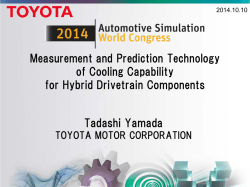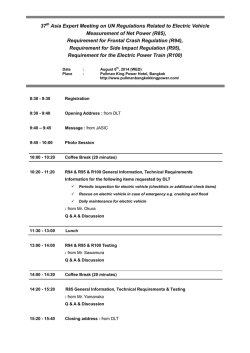
ANALYSIS OF FATAL-SERIOUS ACCIDENTS AND DANGEROUS
Title Author(s) ANALYSIS OF FATAL-SERIOUS ACCIDENTS AND DANGEROUS VEHICLE MOVEMENTS AT ACCESS POINTS ON MALAYSIAN RURAL ROADS マレーシア地 方道路の無信号T交差点での重傷事故と車両危険挙動の 解析 Fajaruddin Bin, Mustakim Citation Issue Date URL 2014-03-31 http://repo.lib.nitech.ac.jp/handle/123456789/21719 Rights Type Textversion Thesis or Dissertation none ・名古屋工業大学学術機関リポジトリは、名古屋工業大学内で生産された学術情報を 電子的に収集・保存・発信するシステムです。 ・論文の著作権は、著者または出版社が保持しています。著作権法で定める権利制限 規定を超える利用については、著作権者に許諾を得てください。 ・Textversion に「Author」と記載された論文は、著者原稿となります。 実際の出版社版とは、レイアウト、字句校正レベルの異同がある場合もあります。 ・Nagoya Institute of Technology Repository Sytem is built to collect, archive and offer electronically the academic information produced by Nagoya Institute of Technology. ・The copyright and related rights of the article are held by authors or publishers. The copyright owners' consents must be required to use it over the curtailment of copyrights. ・Textversion "Author " means the article is author's version. Author version may have some difference in layouts and wordings form publisher version. ⏦ㄳ⪅ࠝFAJARUDDIN BIN MUSTAKIM ࠞ せ᪨ Traffic accidents have been recognized as one of the major causes of human and economic losses in both developed and developing countries. In 2010㸪Malaysia recorded a total of 414,421 accidents㸪 resulting in an average of 19 deaths from road accidents every single day. This research analyzed the factors relevant to fatal and serious accidents on rural federal roads in Malaysia. The objective was to identify the dangerous vehicle movements and factors posing significant risks for fatal-serious accidents at access points (non-signalized minor junctions) and to suggest countermeasures. This research consists of seven Chapters. Firstly㸪Chapter 1 provides a discussion of accident trends and traffic studies in general. 1n Chapter 2㸪the scope was then narrowed down to focus on the accident black spot in order to identify the hazardous or black spot sections. Chapter 3 further examines the quantitative accident records and traffic characteristics for each of the selected sections. vehicle movements at non-signalized intersections. Next㸪Chapter 4 focuses on Chapter 5 provides the methodology and procedures adopted in the development of accident prediction models. Chapter 6 focuses on the development of gap acceptance model. Finally㸪Chapter 7 provides the development of serious conflict model. This research carries out numerous surveys to observe various traffic movements㸪including right and left tums from minor and major roads in addition to many other characteristics㸪in order to construct accident analysis models. One of the findings is that right-turn motorcycles caused serious conflicts and right turn movement was considered to be the most dangerous movement. Based on this finding㸪this research further examines the driver behavior of gap acceptance and serious conflicts using the proposed four gap patterns for a right-turn vehicle from minor to major roads at access points in Road Section 10 of the Federal Road 50 (Unchannelized intersection connected 2-1ane minor and 4-1ane major roads). In addition㸪further analysis is performed to identify the gap pattern and the factors relevant to serious conflicts. The results demonstrated that right-turning vehicles㸪especially motorcycles㸪apparently intended to start turning right in a very short gap and the approaching speed and the gap between a pair of vehicles from opposite directions in the mainstream were the critical factors causing serious conflicts to the right-turn vehicles. In addition㸪 this research studies more on the other two non-signalized intersections located in Road Sectiol1s 2 (Channelized intersection connected 2-1ane minor and 6-1ane major roads) and 9 (Unchannelized intersection connected 2-lane minor and 4-1ane major roads with a traffic signal in close proximity) of the Federal Road 50. The results found that the existence of channelization on the intersection encouraged the right-tum vehicle to accept a longer gap. Furthermore㸪the combined analysis of all the three un-signalized intersections (Road Sections 2㸪9 and 10)㸪reveals that angular serious conflict㸪 nose-tail conflict, and if the second vehicle in the pair in the mainstream is a motorcycle or a passenger car, can significantly influence the right-turn vehicles to accept a short gap. On the other hand a traffic light located in a relatively close distance to the access point, as well as channelization on the intersection can cause the right-turn vehicles to accept longer gaps.
© Copyright 2025








